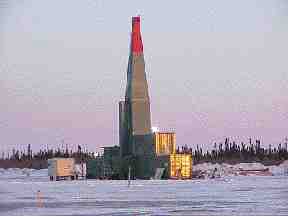Despite mixed results from a study of the Victor diamond project in the James Bay Lowlands of Ontario,
Few details of the scoping-style study are available, though company spokesman Jocelyn Fraser says some “fairly significant technical” issues were identified. Additional studies are necessary to refine capital and working costs for developing a profitable open-pit mine in the isolated region.
The Victor project is 90 km west of the coastal First Nation community of Attawapiskat. It lies 350 km from the nearest road and, for most of the year, access is limited to helicopter. Between December and March, a temporary, 110-km-long winter road is used between the camp and Attawapiskat, where it joins another winter road to Moosonee, some 240 km to the south. An ice runway provides access to light fixed-wing aircraft during the winter months.
Victor occurs in a cluster of 19 kimberlite bodies. De Beers discovered 16 of these bodies by drilling in the late 1980s. More than 100 kg of core from each of the kimberlites was initially analyzed for microdiamonds, and all but one proved to be diamondiferous. The Victor kimberlite is the largest body in the cluster, comprising one larger Main pipe and a smaller SW pipe. The pipes meet near surface and together cover 17 hectares. Victor bodies are covered by at least 6 metres of glacial and marine till.
De Beers returned to the Victor project in November 1999 and drilled a series of large-diameter core holes to provide a better understanding of the size, shape and geology of the kimberlite pipes prior to the start of a major bulk-sampling program. An 80-man exploration camp and temporary winter airstrip were constructed at the time.
At a public information session in the spring of 2000 at Attawapiskat, De Beers representatives revealed that a 330-tonne bulk sample collected in 1999 had yielded 107.9 carats of diamonds with a value of US$16,590. The results implied a preliminary grade of 0.33 carat per tonne, a diamond value of US$154 per carat and a kimberlite value of US$50 per tonne. Fraser cautions that these preliminary valuations were based on a parcel of diamonds that were recovered from just one area of the Victor kimberlites. Victor has been described as geologically complex.
In early 2000, about 5,350 tonnes of kimberlite were extracted from two large surface trenches, while a further 1,168 tonnes were collected from large-diameter holes drilled to a depth of up to 200 metres.
The material was processed through a 10-tonne-per-day treatment plant built on-site. The concentrate material was flown to De Beers’ laboratory in Johannesburg for final diamond recovery. In total, 2,944 carats of diamonds were recovered from 6,262 tonnes of kimberlite, giving an implied grade of 0.47 carat per tonne.
De Beers says data from the large-diameter drill holes showed considerable variation in the concentration of diamonds. Further bulk-sample drilling was conducted on the Victor pipe in the first quarter of 2001, with a total of 28 large-diameter holes completed. In addition, 570 carats were recovered from 1,800 tonnes of kimberlite sample. In total, some 8,392 tonnes of kimberlite collected from Victor have yielded 3,622 carats for an implied grade of 0.43 carat per tonne.
De Beers estimates Victor Main contains an inferred resource of 22.8 million tonnes of kimberlite, whereas Victor SW hosts about 13.3 million tonnes, for a total of 36.2 million tonnes.
Says Jocelyn: “The question now is: can we make a viable mine out of this project?” The recent study, undertaken by De Beers with input from Bechtel Canada, SRK and AMEC, assumed certain costs, including the construction of a permanent all-weather road. The road alone was estimated to cost $80-106 million.
There is a lot of muskeg in the area of the Victor kimberlites, and water management and ground water disposal are issues that require engineering and environmental studies. Hydrology and geotechnical work will be done in the winter of 2002. De Beers also plans to do some geophysical work and delineation drilling to firm up the resource.
“We believe the Victor project may have the potential to become a mine,” the company states in a release. “We have invested a lot of time and effort to get this far. We hope some additional work will help us with the answers to the problems we have found.”
De Beers is a partially owned unit of


Be the first to comment on "FPO De Beers looks to trim costs at Victor"